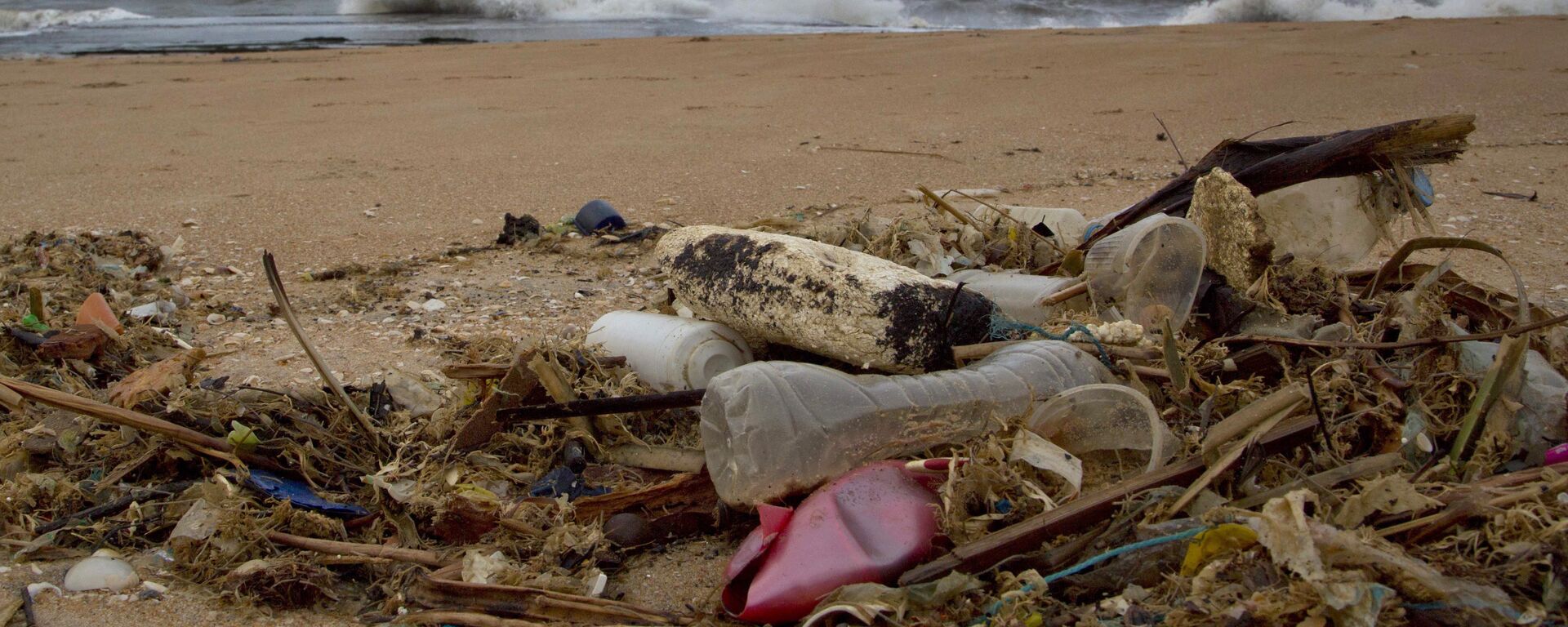https://sputnikglobe.com/20221005/wax-worm-saliva-could-help-decompose-plastics-1101516965.html
Wax Worm Saliva Could Help Decompose Plastics
Wax Worm Saliva Could Help Decompose Plastics
Sputnik International
Plastics have permeated our society since their invention. Our clothing, bedding, toothbrushes, keyboards, cars and of course, packaging, is all made from... 05.10.2022, Sputnik International
2022-10-05T03:47+0000
2022-10-05T03:47+0000
2022-10-19T18:53+0000
science & tech
plastic
plastic pollution
animals
environment
https://cdn1.img.sputnikglobe.com/img/107720/33/1077203396_0:286:2913:1925_1920x0_80_0_0_f59b51cfe6dc370b732538e1e4c9dfbb.jpg
Since the 1950s, 9 billion tons of plastics have been thrown out, and only 9% of that waste has actually been recycled, while just 12% of it has been incinerated.Some 400 million tons of plastic are thrown out every year, and the material that makes plastic so desirable due to its cost-efficient durability is also one of the reasons it takes so long to break down. Some types of plastics will take thousands, or even tens of thousands of years to degrade in a landfill. And even when the plastic does break down, its microscopic particles pollute our ocean, air, ecosystems and, of course, our bodies.A third of plastics are made up of polyethylene. Some microorganisms in previous studies have been able to release enzymes that can start the degradation process, though that takes months to occur. But Dr. Federica Bertocchini, a researcher and hobbyist beekeeper, says she may have found a solution that takes only hours to decompose polyethylene.The study, prompted by Bertocchini’s exciting discovery, was published in the journal Nature Communications. The researchers write that Galleria mellonella (wax worm) larvae are capable of oxidizing and polymerizing polyethylene when the material has been sitting in room temperatures.“Within the saliva, we identify two enzymes, belonging to the phenol oxidase family, that can reproduce the same effect. To the best of our knowledge, these enzymes are the first animal enzymes with this capability, opening the way to potential solutions for plastic waste management through bio-recycling/up-cycling,” the study says.The team found 200 proteins in the wax worm’s saliva and narrowed down their findings to just two types of proteins that may be responsible for breaking down polyethylene—the consumer plastic. But Bertocchini says she and her team are still trying to figure out how exactly the wax worms were able to degrade the plastic, and stress that further, strenuous, research must be conducted before they can assume that they found the answer to the issue of plastic pollution. But Bertocchini remains hopeful."We can also imagine small amounts that can reach more remote locations, like villages or small islands, where waste facilities are not available."
https://sputnikglobe.com/20220429/california-ag-announces-investigation-into-oil-industry-over-plastics-crisis-1095135343.html
Sputnik International
feedback@sputniknews.com
+74956456601
MIA „Rosiya Segodnya“
2022
Mary Manley
https://cdn1.img.sputnikglobe.com/img/07e6/01/0b/1092187887_0:0:2048:2049_100x100_80_0_0_0c2cc4c84f89aff034cc55bb01fb6697.jpg
Mary Manley
https://cdn1.img.sputnikglobe.com/img/07e6/01/0b/1092187887_0:0:2048:2049_100x100_80_0_0_0c2cc4c84f89aff034cc55bb01fb6697.jpg
News
en_EN
Sputnik International
feedback@sputniknews.com
+74956456601
MIA „Rosiya Segodnya“
Sputnik International
feedback@sputniknews.com
+74956456601
MIA „Rosiya Segodnya“
Mary Manley
https://cdn1.img.sputnikglobe.com/img/07e6/01/0b/1092187887_0:0:2048:2049_100x100_80_0_0_0c2cc4c84f89aff034cc55bb01fb6697.jpg
science & tech, plastic, plastic pollution, animals, environment
science & tech, plastic, plastic pollution, animals, environment
Wax Worm Saliva Could Help Decompose Plastics
03:47 GMT 05.10.2022 (Updated: 18:53 GMT 19.10.2022) Plastics have permeated our society since their invention. Our clothing, bedding, toothbrushes, keyboards, cars and of course, packaging, is all made from plastics. Plastic was first invented in 1862 by Alexander Parkes. Then, in the post-war period, plastics became a major pollution problem once they started replacing consumer packaging.
Since the
1950s, 9 billion tons of plastics have been thrown out, and only 9% of that waste has actually been recycled, while just 12% of it has been incinerated.
Some 400 million tons of
plastic are thrown out every year, and the material that makes plastic so desirable due to its cost-efficient durability is also one of the reasons it takes so long to break down. Some types of plastics will take thousands, or even tens of thousands of years to degrade in a landfill. And even when the plastic does break down, its microscopic particles pollute our ocean, air, ecosystems and, of course, our bodies.
A third of plastics are made up of polyethylene. Some microorganisms in previous studies have been able to release enzymes that can start the degradation process, though that takes months to occur. But Dr. Federica Bertocchini, a researcher and hobbyist beekeeper, says she may have found a solution that takes only hours to decompose polyethylene.
“My beehives were plagued with wax worms, so I started cleaning them, putting the worms in a plastic bag,” said Bertocchini, at the Biological Research Centre in Madrid. “After a while, I noticed lots of holes and we found it wasn’t only chewing, it was [chemical breakdown], so that was the beginning of the story.”
The study, prompted by Bertocchini’s exciting discovery, was published in the journal
Nature Communications. The researchers write that
Galleria mellonella (wax worm) larvae are capable of oxidizing and polymerizing polyethylene when the material has been sitting in room temperatures.
“We report that the saliva of Galleria mellonella larvae (wax worms) is capable of oxidizing and depolymerizing polyethylene (PE), one of the most produced and sturdy polyolefin-derived plastics. This effect is achieved after a few hours’ exposure at room temperature under physiological conditions (neutral pH),” writes Tuesday’s study. “The wax worm saliva can overcome the bottleneck step in PE biodegradation, namely the initial oxidation step.”
“Within the saliva, we identify two enzymes, belonging to the phenol oxidase family, that can reproduce the same effect. To the best of our knowledge, these enzymes are the first animal enzymes with this capability, opening the way to potential solutions for plastic waste management through bio-recycling/up-cycling,” the study says.
The team found 200 proteins in the wax worm’s saliva and narrowed down their findings to just two types of proteins that may be responsible for breaking down polyethylene—the consumer plastic.
But Bertocchini says she and her team are still trying to figure out how exactly the wax worms were able to degrade the plastic, and stress that further, strenuous, research must be conducted before they can assume that they found the answer to the issue of plastic pollution. But Bertocchini remains hopeful."We can imagine a scenario where these enzymes are used in an aqueous solution, and litres of this solution is poured over piles of collected plastic in a waste management facility," said Bertocchini, adding that families may be able to degrade plastic waste at home.
"We can also imagine small amounts that can reach more remote locations, like villages or small islands, where waste facilities are not available."





